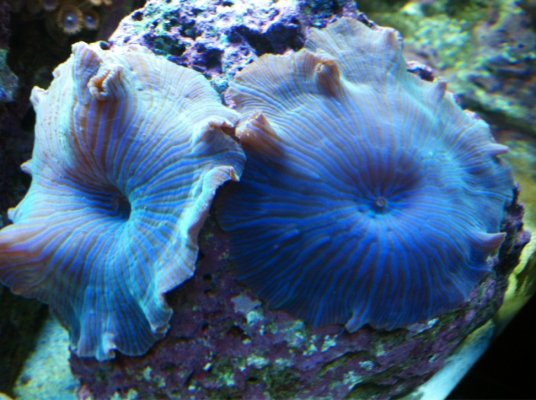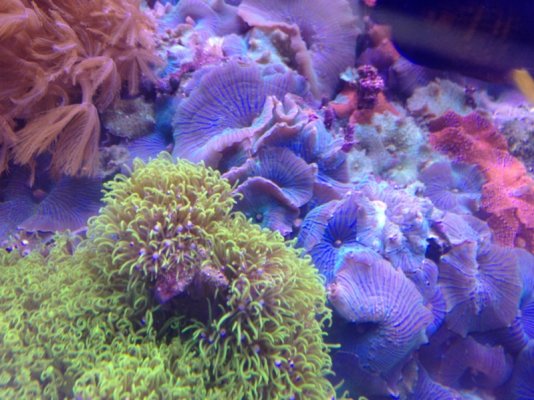You are using an out of date browser. It may not display this or other websites correctly.
You should upgrade or use an alternative browser.
You should upgrade or use an alternative browser.
Which type if mushroom?
- Thread starter jillw28
- Start date
The friendliest place on the web for anyone with an interest in aquariums or fish keeping!
If you have answers, please help by responding to the unanswered posts.
If you have answers, please help by responding to the unanswered posts.
Supa Belle
Aquarium Advice Freak
Looks like a blue mushroom coral
Supa Belle
Aquarium Advice Freak
Coral Basic Stats Care Level: Easy Placement: All Lighting: Moderate Waterflow: Low to Medium Temperament: Semi-Agressive Water Conditions: 72-78° F, dKH 8-12, pH 8.1-8.4, sg 1.023-1.025 Scientific Name: Actinodiscus sp. Mouse over image to enlarge Blue Mushroom Soft Coral The Blue Mushroom Coral, and all other Actinodiscus are very hardy and easy to maintain, making them a perfect candidate for beginner reef hobbyists. The lack of need for high lighting makes it easier for those just getting into the hobby to care for this coral. As they are very hardy, they can withstand the mistakes of novice reefers and can bounce back with ease. Under the right conditions, they can multiply quite rapidly, filling your tank with beautiful colors for a low price, a plus for anyone just getting into reefing. Mushrooms in general need moderate lighting so placement on the lower part of the tank is best. Too much lighting can burn your coral and cause bleaching so make sure to not place your mushroom corals too high in the tank. They also do not like too much water movement, so low placement helps assure they don't get too much current as well. They are semi-aggressive so they do require a little space between other species and other corals. This coral receives some of it's nutrients from photosynthesis, as they contain the symbiotic algae zooxanthellae, a photosynthetic algae living symbiotically within it. Although it is photosynthetic, it is still beneficial to have an addition of brine shrimp, microplankton, phytoplankton, and other filter feeding foods designed for filter feeders added to your reef tank. As some of their nutrients are received by light, it is important to have adequate lighting to your reef tank in order to exhibit good growth for the coral. Blue Mushroom Propagation Note: The tools used for propagating your reef corals must always be designated for your reef tank only. Make sure to always wash and rinse these tools in order to refrain from contaminating your tank with any unknown substances that may harm your tank. To be safe, always wear goggles as some corals can secrete (such as Zoanthids) a toxin that may be harmful, or even deadly to humans. Always use care in propagating your corals and use gloves if you deem necessary, dependant on coral species. Powder-free latex gloves can keep from getting any contaminants from your fingers onto the coral. Always rinse out and dry any tools used to propagate your corals to keep from any rust forming for later use. Reef glue bought at your local LFS is best for use, or you can purchase any super glue that is in the form of gel. Make sure to only purchase super glue that has Cyanoacrylate, as these are the ones that are reef safe. Propagating Mushroom Corals is probably one one of the easiest out of all coral propagations. There are a couple methods to use. First method is for those who do not want to cut the mushroom. It may not work for all, but it is an option. If possible, simply use bone cutters to cut a part of the rock that the mushroom is on, placing this rock on a bigger rock and letting them multiply on that new rock. As mushrooms can quickly split and multiply, this method works well for those who do not want to do any cutting. Now, if you do want to split your mushroom, here is that method. If the mushroom is attached to a piece of live rock, simply use a sharp razor or box cutters to slice the mushroom off the rock as close to the rock (losing as little flesh as you can) as possible. You now have the mushroom by itself. Place the mushroom face up on a clean and flat surface (I use a piece of glass or mirror for this). Using a sharp razor blade or box cutters, slice the mushroom in half. Each piece can now be taken and put into a container or bottle (anything that allows light, but does not allow too much water flow or nippy tank inhabitants into the container) that has little rock rubbles, some use tank pebble sized rubble, on the bottom of the container. Put a piece of mesh over it and secure so the mushroom has enough room to cause little stress, but not enough room for it to move around too much. Within a few days, the mushroom should attach to a piece of rubble, which can then be glued onto a frag plug or bigger rock later. Some have cut a single mushroom into fourths instead of half, and still manage to get all four pieces to grow. Though a warning, this may not work all the time... You may lose once piece, you may lose two... you may lose all. The smaller you cut the pieces, the less of a chance you have for survival; though I must say, it does work. Just make sure all pieces have a piece of the stalk on it, as that is what it uses to attach to the rock and regrow itself. Do not use glue on mushroom corals. It will not work. The mushroom has a slimy substance that it will secrete when glued, and it will just remove itself from the glue leaving you with a lost mushroom coral somewhere in the crevices of your rocks. You must allow it to attach itself. Note: It is recommended to allow ample time for your frag to heal. You can do this by placing on a frag rack prior to placement for a couple of weeks, or simply designating an area in your tank for frags. Once the coral is showing good health, you can then place your frag in your rockwork.
jillw28
Aquarium Advice Apprentice
Wow! Great info! Ty so much!
Supa Belle
Aquarium Advice Freak
No prob 
HovaRockz
Aquarium Advice Freak
- Joined
- Nov 15, 2012
- Messages
- 361
Lol great info... No need to frag just allow them to spread first before you begin fragging
HovaRockz
Aquarium Advice Freak
- Joined
- Nov 15, 2012
- Messages
- 361
Looks beautiful and very healthy by the way
Supa Belle
Aquarium Advice Freak
I wouldn't frag it if move them around and let them spread on there own I wouldn't have the heart to cut them
Gregcoyote
Aquarium Advice Addict
Similar threads
- Replies
- 4
- Views
- 430
- Replies
- 9
- Views
- 432
- Replies
- 1
- Views
- 333
- Replies
- 11
- Views
- 508


